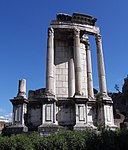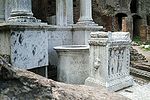Regia

The Regia ("Royal house") was a two-part structure in Ancient Rome lying along the Sacra Via at the edge of the Roman Forum that originally served as the residence or one of the main headquarters of kings of Rome and later as the office of the Pontifex Maximus, the highest religious official of Rome. It occupied a triangular patch of terrain between the Temple of Vesta, the Temple of Divus Julius and Temple of Antoninus and Faustina. Only the foundations of Republican/Imperial Regia remain. Like the Curia it was destroyed and rebuilt several times, as far back as the Roman monarchy. Studies have found multiple layers of similar buildings with more regular features, prompting the theory that this "Republican Regia" was to have a different use.
Excerpt from the Wikipedia article Regia (License: CC BY-SA 3.0, Authors, Images).Regia
Via di San Teodoro, Rome Municipio Roma I
Geographical coordinates (GPS) Address Nearby Places Show on map
Geographical coordinates (GPS)
| Latitude | Longitude |
|---|---|
| N 41.891967 ° | E 12.486595 ° |
Address
Forum Romanum
Via di San Teodoro
00184 Rome, Municipio Roma I
Lazio, Italy
Open on Google Maps









